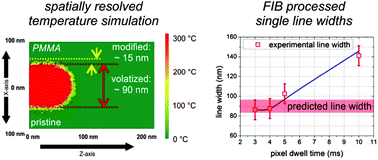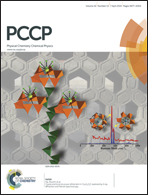A combined approach to predict spatial temperature evolution and its consequences during FIB processing of soft matter†
Abstract
Accessing local temperatures and their evolution during focused ion beam (FIB) processing is of particular importance in the context of polymers or biomaterials as they tend to undergo severe chemical and morphological damage due to the high temperatures arising. In this study we present a combination of ion trajectory simulations and thermal spike model based calculations, which allows predicting local temperatures, lateral distributions and evolution during FIB patterning. Simulations and calculations have been done without any approximation or correction factors and lead to results in very good agreement with experiments on polymers taking into account their thermal behaviour. Finally, the model is applied to different scanning strategies which demonstrate how classically applied patterning strategies lead to massive temperature increases which can be the knock out criteria for low melting materials.


 Please wait while we load your content...
Please wait while we load your content...